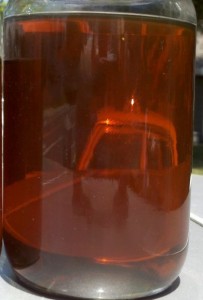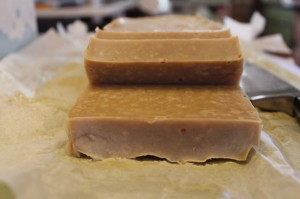Soap from WVO
In case your entire family isn’t yet on board with your WVO endeavors, here is a way to incorporate the whole gang(and especially the neat-freaks) into the fold. You can transform WVO into soap! It’s a simple and sometimes profitable process being done in homes all across the country.
For at least the last 4800yrs human-kind has been making soap. As WVO’ers we have an abundance of the key ingredient, oil. So why not give it a try?
Soap can be easily made using the “Cold Process Method”. The three basic ingredients are Oil, Lye and Water.
You mix an acid(oil) and a base(NaOH) with water to get glycerin and soap. Glycerin is the moisturizing part, while soap does the cleaning.
Step 1:
Take some finely cleaned WVO from your fuel supply.
Step 2:
Mix Oil with recommended amount of lye and water.
Oil to Lye ratios vary depending on the type of oil used. The saponification value of the WVO will determine the amount of lye needed. Saponificaton charts are easily found online. More lye the better oil cutting properties, more water the more moisturizing. The water to oil ratio is 3:8 Add lye to water(not water to the lye) and ventilate! Potassium Hydroxide(KOH) is used for liquid soaps. Soemtimes palm soil sterin is added ot make soap harder. Add fragrances here as well.
Step 3:
Pour into soap mold, whatever shape you want your soap to be.
Step 4:
Remove from mold and let soap cure for a few weeks.
This article was inspired by Summit Soap’s endeavor to upcycle WVO into soap. They have diversified their value added wvo collection biz by making and selling WVO Soap locally. With an essentially limitless feedstock of oil, they are maximizing the value of the WVO by diverting some of the flow into soap, instead of biodiesel. And, the value per gallon of soap is much higher than Biodiesel.
Here is a decent video I came across which explains the cold process soap method.
by Jason Jelonek


Gerry Schreiber says:
Thursday, September 19, 2013 at 11:08pm
You should know that a saponification chart doesn’t help much with a mixture of WVO collected from restaurants that use the same oil for frying/cooking many food items.
A titration must be done to get it just right.